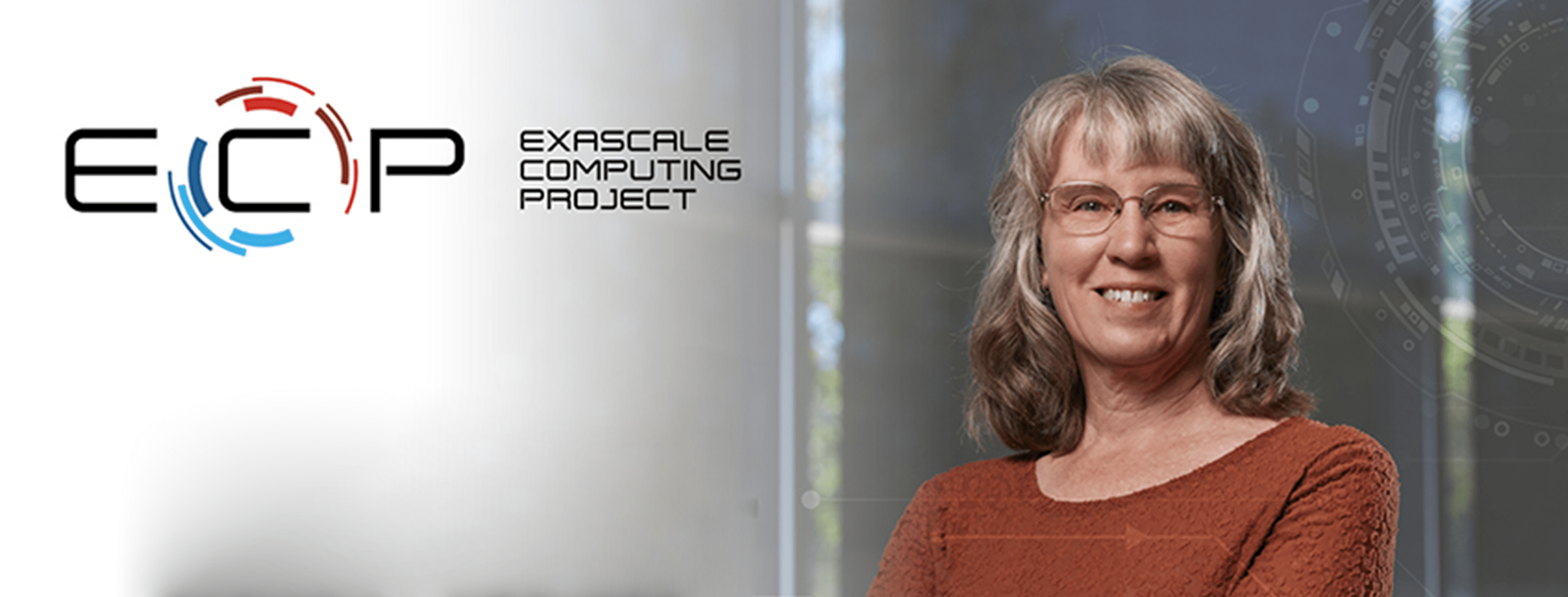
The Computational Science Graduate Fellowship (CSGF) Annual Program Review gave DOE laboratories a chance to show off their research opportunities in hopes of attracting bright, young talent. Judy Hill, a computational scientist for the OLCF and an alumna of the program, served as the facility’s point person for the event. She led OLCF’s presentation at the conference’s poster session.
Event seeks long-lasting relationships, not just recruiting opportunity
Computational Science Graduate Fellowship (CSGF) Annual Program Review, held in June, gave Department of Energy (DOE) laboratories a chance to show off their research opportunities in hopes of attracting bright, young talent.
While immediate recruiting was an important goal of the session, Judy Hill, a computational scientist for the Oak Ridge Leadership Computing Facility (OLCF), emphasized the value of true, long-term connections with fellows and alumni alike.
DOE’s CSGF awards 4-year fellowships to graduate students in science and engineering fields that use high-performance computing (HPC) to solve complex problems. An acceptance rate of only 2 percent makes it the most prestigious such fellowship in the nation, so it’s no surprise that CSGF attracts promising minds in a variety of topics.
Hill described the fellowship as a “workforce development program where we’re training the next generation of computational scientists to do the kinds of things that we do here in the Scientific Computing Group.”
The CSGF is unique in its interdisciplinary approach. It seeks to expand the field of computational science by looking at applicants from a wide range of disciplines. Areas of study for current fellows range from theoretical neuroscience to environmental modeling. Regardless of their background, these fellows share a common interest in using computing to further their research.
“It’s really a way to introduce computational science and the breadth of the curriculum that’s needed.” Hill explained. “Computational scientists need courses in math, computer science, as well as a scientific domain. Many universities don’t offer that kind of curriculum, so the fellowship was developed to fill that gap.”
While some may criticize a wide-ranging approach in favor of a more narrow focus, Hill maintains that it is a significant advantage of the fellowship.
“We’ve found that through this program, and through the networking and interaction that these people have outside their research domain, they’ve often found connections. And in fact you’ll find that one research area has solved a problem that another researcher didn’t know anything about. So a population like this that comes from a wide background of scientific domains makes those connections.”
“Connections” is a word that Hill stresses. The program review gives fellows a one-of-a-kind opportunity to network with scientists from a wide variety of disciplines and organizations.
“Part of the program review is that labs go there and introduce fellows to opportunities at their lab so the fellows can choose internships that both match their own research interests and would provide some breadth beyond the thesis research.”
In addition to a generous yearly stipend and full tuition, the fellowship awards recipients with a summer practicum at the lab of their choice. Their time at the program review is often instrumental in deciding where they want to complete this practicum.
Much of the direct networking happens at the DOE laboratory poster session, the primary focus of Hill’s time at the conference.
“My main goal is to introduce them to the OLCF and all the exciting research that goes on,” Hill explained. “So what I try and do is talk about the facility and the opportunities people have to use that, but also to talk about the collaborative environment we have. I truly believe that Oak Ridge is one of the best places to work, that’s why I work here. I try to instill that in these fellows—that this is a place that they’ll want to come.”
Hill emphasized that it’s all about cultivating a relationship.
“I spend a lot of time not letting them ask me questions. Instead, I ask them questions about what they’re interested in and then offer them possibilities, see what piques their interest, and try to find that where their eyes light up. Saying, ‘Oh they like that. What else can I think of along those lines?’”
This collaborative process encourages cooperation and long-term connections. The result is that nearly one-third of fellows work in a DOE laboratory at some point in their career.
While this mutually beneficial relationship is obviously important, Hills emphasizes that the fellowship is more than just a way to recruit future talent.
“This isn’t only about the pipeline to the laboratories; it’s about creating a community that recognizes the value of this interdisciplinary and multidisciplinary work. Twenty-five years ago when the fellowship was being proposed, that didn’t happen at universities. So it’s also a win if people go into academia and promote this kind of work. It’s a win if they go to industry and do this kind of work.”
As an alumna of the fellowship herself, Hill knows firsthand the positive impact that this can have on fellows’ careers.
“I wouldn’t be here today if I wasn’t in that program,” Hill stated. “The program allowed me to learn about computing, which I didn’t know anything about before I started. It exposed me to the laboratories . . . and helped me when I came to Oak Ridge. I’m starting to get to the point where I’m serving on program committees and in leadership roles, and a lot of these opportunities are coming from this network. So it has had, and continues to have, an impact on my life and on my career. “
Ongoing improvements in HPC capabilities have greatly expanded the scope and type of problems looking to computing for solutions and have necessitated a more multidisciplinary emphasis. The CSGF allows laboratories like ORNL to develop, recruit, and connect the brightest young minds with established professionals who continue to make strides across the scientific world.
While attending the event, Hill also participated in a panel session about the computational facilities available at DOE laboratories and gave a talk about the kinds of concepts a computational scientist worries about from an applications perspective. —Christie Thiessen






